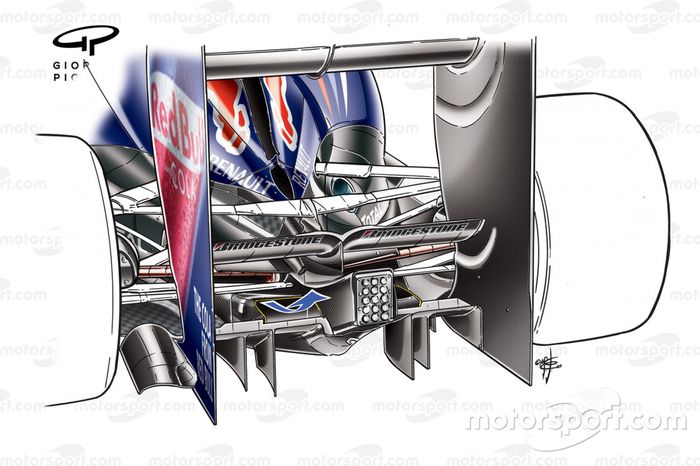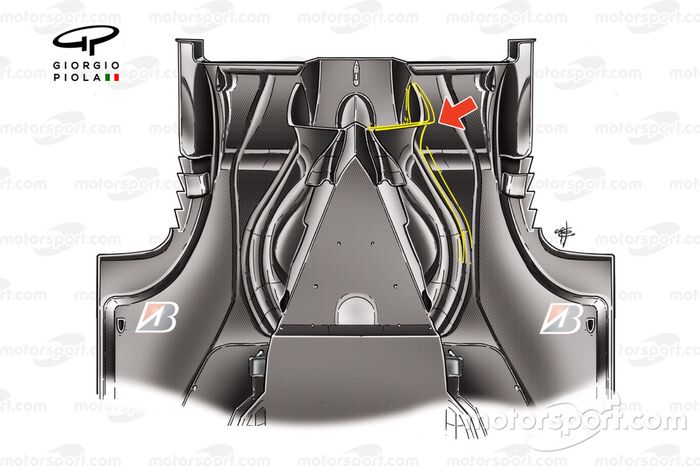Banned: Why double diffusers were outlawed
The 2009 Formula 1 season will long be remembered as the year that Brawn GP emerged from the ashes of the Honda team and went on to win the world championship.

Photo by: Giorgio Piola
But, the bottom nearly fell out of its challenge as soon as the season started, with a row erupting over a contentious design feature of its car: the infamous double diffuser.
We take a look back at why the concept that some teams got a head start on wasn't banned immediately, and how everyone reacted that season.
The wide sweeping rule changes introduced for 2009, with the intent of improving the ability of drivers to follow one another and thus improve overtaking, had sought to reduce the overall downforce that was achievable.
F1's designers were clearly in search of ways of reversing this and three teams, who don't at first seem remotely connected, universally struck upon the idea of adding a secondary tier to their diffuser.
It's an idea that was reportedly dreamt up by Super Aguri designers working on plans for the then 2008 rule change.
The team's demise would see its personnel go off in different directions, although most would find their way to Honda, who'd been bankrolling the exercise to a large extent anyway. Some landed with the other Japanese team on the grid – Toyota, or the Toyota-powered team Williams.
The double deck diffuser that could be seen on the BGP001, the Toyota TF109 and Williams FW31 was immediately put under scrutiny by the rest of the grid, who'd clearly missed an opportunity to expand the volume of their diffuser and sought to remove any advantage the three teams had gained.


The rules introduced for 2009 had set about limiting the dimensions of the diffuser to 1000mm wide, 175mm tall and 350mm long.
The use of the double diffuser arrangement hinged on the wording on article 3.12.7 of F1's Technical Regulations.
It stated: "No bodywork which is visible from beneath the car and which lies between the rear wheel centre line and a point 350mm rearward of it may be more than 175mm above the reference plane. Any intersection of the surfaces in this area with a lateral or longitudinal vertical plane should form one continuous line which is visible from beneath the car."
The fact that this only required for the designers to be compliant in one dimension opened up the possibility for channels to be created, which allowed airflow to move into the upper deck of the diffuser.


This was an ingenious workaround that exposed the way in which the regulations had been written.
The design did not go down well with the other teams which, having missed the trick, knew it would be an issue to get a double diffuser incorporated on to their cars in the short term.
As such, they opted to protest the design at the Australian GP and lobby the FIA not only to ban the design going forward but also reverse the result of the Melbourne race.

Brawn BGP 001 2009 double diffuser detail view
Photo by: Giorgio Piola
Playing their hand in this way is just one way of winning though, as whilst in the public spotlight they appear to be doing the gentlemanly thing of having a borderline solution banned, they're also hiding a trump card up their sleeve: working on their own solution in case their political manoeuvres backfire.
In this case, the politics failed them, as they were unable to lobby for the double diffuser's removal. So now they'd have to fast track designs from the drawing board and get them on the car as quickly as possible.
The scale of this endeavour should not be underestimated, given how having more downforce on the rear-end would have to be matched at the front for aero balance purposes.
The benefits of the diffuser could not be ignored though, given how much downforce could be gained, and so everyone set about introducing their own version.

Red Bull RB5 2009 rear suspension detail
Photo by: Giorgio Piola
Red Bull had the biggest challenge, as it had reintroduced pull rod suspension at the rear of the car. This was a decision that has had an effect on the design of F1 cars ever since, with everyone seeing the packaging and aerodynamic advantages on offer.
It would, however, make life difficult for Adrian Newey and his team, as the pull rod joined the gearbox and crash structure assembly right on the diffuser kick line. This made it extremely difficult to get the best from a double diffuser.
Nothing is insurmountable though and Red Bull, knowing it needed this solution, set about making the necessary changes, irrespective of the upheaval it would have.
A challenge for everyone….
Red Bull might have had the biggest challenges to overcome to install a double diffuser but that's not to say the others had it easy either.
Be part of Motorsport community
Join the conversationShare Or Save This Story
Subscribe and access Motorsport.com with your ad-blocker.
From Formula 1 to MotoGP we report straight from the paddock because we love our sport, just like you. In order to keep delivering our expert journalism, our website uses advertising. Still, we want to give you the opportunity to enjoy an ad-free and tracker-free website and to continue using your adblocker.





























Top Comments